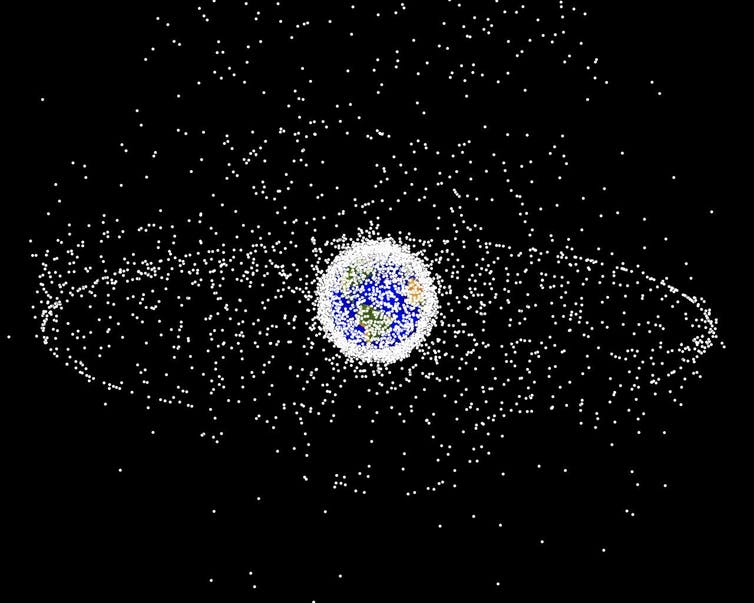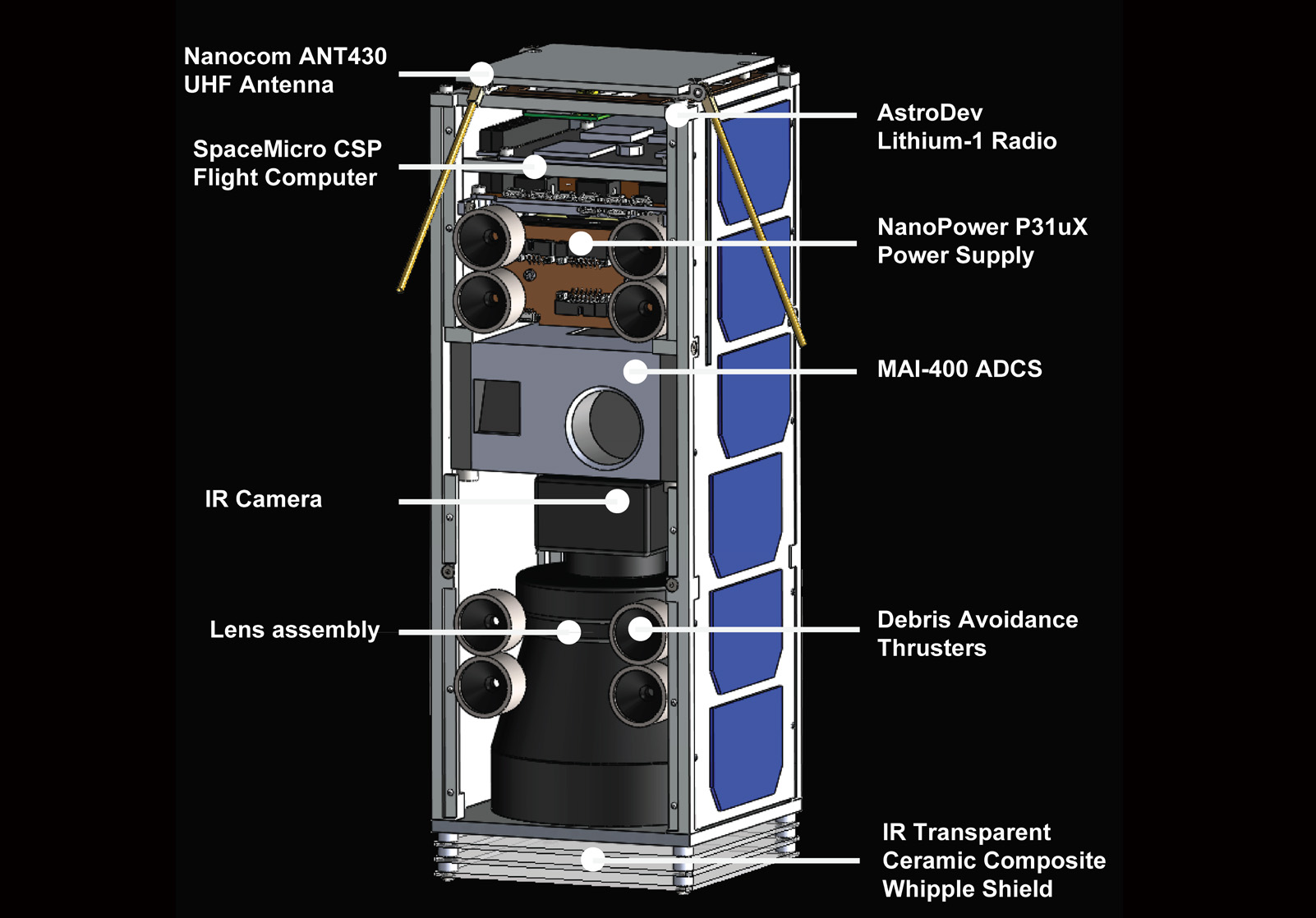Scientists Propose New Satellite Tech to Dodge Space Junk from Megaconstellations
Gel-based thrusters?

If a disastrous space junk chain reaction ends up surrounding Earth with a belt of destructive shrapnel, state-of-the-art infrared cameras and gel-based rockets just might help future satellites dodge such debris, a new study finds.
Space debris might not sound dangerous until one realizes that in low Earth orbit — up to about 1,200 miles (2,000 kilometers) in altitude — such debris collides with an average speed of about 22,370 mph (36,000 km/h), according to NASA. At such speeds, even tiny pieces of space debris can inflict devastating damage.
Collisions with space debris have already led to millions of dollars in losses. For example, on Feb. 10, 2009, an active U.S. communications satellite called Iridium 33 was obliterated when it was struck by a defunct Russian satellite Cosmos 2251 built in the 1960s.
In addition, such disasters can generate more debris that could go on to destroy more objects in orbit, a cascade of destruction that might ultimately create a debris belt around Earth. This worst-case chain-reaction scenario is known as the "Kessler effect" or "Kessler syndrome," a scenario that NASA scientist Donald Kessler predicted in 1978.
Video: The Global Threat of Space Debris
Related: 7 Wild Ways to Clean Up Space Junk
The Rise of megaconstellations
Currently about 500,000 marble-size pieces of debris and more than 100 million objects a millimeter or less in size are estimated to orbit Earth, according to NASA. Furthermore, since it has become cheaper than ever to build and launch satellites, companies such as SpaceX, Amazon, OneWeb and Telesat are planning to launch "megaconstellations" into low Earth orbit in the next few years, and each will be composed of hundreds of miniature satellites.
A study in 2017 suggested the collisions one might expect to occur with such megaconstellations might significantly exacerbate the risk of the Kessler effect. In fact, the European Space Agency had to move its Aeolus Earth-observation satellite on Sept. 2 to avoid a potential collision with a SpaceX Starlink satellite, one of 60 such satellites launched at the same time in May of this year.
Get the Space.com Newsletter
Breaking space news, the latest updates on rocket launches, skywatching events and more!
To prepare for the possibility of the Kessler effect, scientists analyzed how satellites might continue to survive and operate when space debris dominates low Earth orbit.
"Given how a whole bunch of companies are now proposing megaconstellations that would cram up to thousands of satellites into low Earth orbit, it's not a matter of if but when these things start to collide and cause this ripple effect of accidents," Jekan Thangavelautham, an aerospace engineer at the University of Arizona, told Space.com. Thangavelautham is senior author of the new study on space debris, which he and colleagues presented on Sept. 18 at the Advanced Maui Optical and Space Surveillance Technologies Conference in Hawaii.
Related: European Satellite Dodges Potential Crash with SpaceX Starlink Craft
Avoiding the Kessler syndrome
When it comes to miniature bits of space debris, prior work suggested that satellites could get protected using defenses known as Whipple shields.
These consist of a relatively thin cover over the main wall of a spacecraft, which breaks up and disperses incoming debris. This spreads the energy of the impact over a larger area, making it easier to withstand. However, Whipple shields can only protect against debris 0.4 inches (1 centimeter) wide or smaller, the researchers said.
For big chunks of space debris, ground-based radar and telescopes can remotely track their movements, helping scientists predict their trajectories. Satellites can then get instructed on how to best maneuver to prevent impacts. However, such "remote avoidance" strategies are limited, because NASA and the Department of Defense cannot track objects smaller than 2 inches (5 cm) in size, the new study noted.
The scientists focused on how satellites might deal with debris too small to be tracked from the ground yet big enough to penetrate Whipple shields. They suggested that an onboard thermal infrared camera might help a satellite quickly detect minuscule levels of heat from this mid-size debris on the scale of tens of miles away, all without any input from the ground.
However, even if a satellite could detect incoming space junk from tens of miles away, given the speed at which orbital debris travels, satellites would only have seconds to dodge a collision. The researchers suggested using rockets that use solid propellants, as these are high-thrust, lightweight and reliable, and can activate in a fraction of a second — all for a fast, rough push out of harm's way.
Space junk-dodging cubesat

To test their ideas, the scientists proposed developing a cubesat — a satellite based on cubes just about 4 inches (10 cm) wide. They suggested creating a breadloaf-size cubesat the size of three such cubes with 16 solid-propellant thrusters and a thermal infrared camera with a ceramic Whipple shield transparent to infrared rays.
"We want to keep the design fundamentally simple, for a system that doesn't cost an arm and a leg," Thangavelautham said.
The most common type of solid-propellant rockets can each be used only once. Part of the reason the researchers' proposed avoidance system has multiple thrusters is so that it can help a satellite evade multiple potential collisions if necessary.
Alternatively, there are rockets that use solid gels as propellant instead that can each fire many times — "these could increase the number of times a satellite could dodge debris," Thangavelautham said.
- Latest News About Space Junk and Orbital Debris
- Space Junk Explained: The Orbital Debris Threat (Infographic)
- SpaceX's 1st Starlink Satellite Megaconstellation Launch in Photos
Follow Charles Q. Choi on Twitter @cqchoi. Follow us on Twitter @Spacedotcom and on Facebook.
Join our Space Forums to keep talking space on the latest missions, night sky and more! And if you have a news tip, correction or comment, let us know at: community@space.com.

Charles Q. Choi is a contributing writer for Space.com and Live Science. He covers all things human origins and astronomy as well as physics, animals and general science topics. Charles has a Master of Arts degree from the University of Missouri-Columbia, School of Journalism and a Bachelor of Arts degree from the University of South Florida. Charles has visited every continent on Earth, drinking rancid yak butter tea in Lhasa, snorkeling with sea lions in the Galapagos and even climbing an iceberg in Antarctica. Visit him at http://www.sciwriter.us









